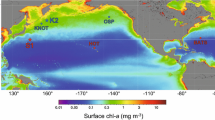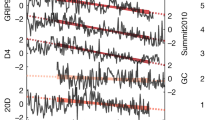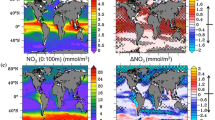Abstract
Our goal was to provide a high-resolution temporal data base for modeling primary production in shelf waters adjacent to Palmer Station, Antarctica. Here, the resulting 1991/1992 data base is used to: (1) determine in situ productivity over a range of seasonal to subseasonal time scales; (2) identify time scales of significant variability in marine productivity during the peak growing season; (3) identify environmental, experimental and analytical factors that can significantly impact the accuracy of daily, weekly and seasonal productivity estimates; and (4) integrate our findings with previous studies of Antarctic coastal primary pro- duction. Data were gathered every 2–3 days during a 3-month period in the austral spring/summer of 1991/1992. Photosynthesis-irradiance (P-I) relationships were determined throughout the euphotic zone and P-I parameters, combined with knowledge of the in-water light field, were used to derive instantaneous rates of in situ primary production. Additionally, weekly samples were collected from surface and chlorophyll a maxima for characterization of the patterns of diel periodicity in P-I parameters. Seven diel patterns were discerned over the season and used to time-correct instantaneous measurements and derive noontime, daily, monthly and seasonally integrated estimates of production. During the season, a large bloom was responsible for some of the highest daily produc- tivity rates reported for the Southern Ocean (0.8 g C m-3 d-1, 6.3 g C m-2 d-1). Significant variation in daily integrated rates occurred generally on time scales less than a week. Peak timing and magnitude of daytime periodicities in photosynthesis varied widely over the season, closely coupled to changes in phytoplankton community composition. Instantaneous measurements of primary production, if uncorrected or improperly corrected for daytime periodicities in carbon fixation, were unreliable predictors of production on longer time scales even if the water column was sampled every few days. High frequency sampling and consideration of diel periodicity may be requirements when attempting to discern differences between short time-scale variability and long-term trends in Antarctic primary production.
Similar content being viewed by others
Author information
Authors and Affiliations
Additional information
Received: 9 October 1995/Accepted: 18 February 1996
Rights and permissions
About this article
Cite this article
Moline, M.A., Prézelin, B.B. High-resolution time-series data for 1991/1992 primary production and related parameters at a Palmer LTER coastal site: implications for modeling carbon fixation in the Southern Ocean. Polar Biol 17, 39–53 (1997). https://doi.org/10.1007/s003000050103
Published:
Issue Date:
DOI: https://doi.org/10.1007/s003000050103




